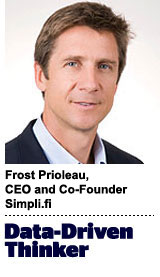 “Data-Driven Thinking” is written by members of the media community and contains fresh ideas on the digital revolution in media.
“Data-Driven Thinking” is written by members of the media community and contains fresh ideas on the digital revolution in media.
Today’s column is written by Frost Prioleau, CEO and co-founder of Simpli.fi.
From programmatic’s perch on the bleeding edge of advertising technology, it could be easy to dismiss radio as an advertising medium of a bygone era.
But despite the tectonic shifts in the radio industry and listening habits of Americans, radio reaches 92% of all Americans age 12 or older every week, estimates Nielsen Audio. Combined with an emotional connection driven by music, on-air personalities and community spirit, it’s easy to understand why radio remains an important part of the local advertising media mix.
The radio advertising industry was worth nearly $5 billion industry in 2013, according to Borrell Associates. Digital advertising sold by radio reps accounted for $500 million, a 22% increase from the previous year. For the most part, these digital revenues are from digital services such as search engine optimization and social media management, which leverage radio’s strong referral patterns for online search and social media engagement.
However, it seems that very few stations so far have tuned into the opportunity in targeted display. That will begin to change as targeted display drives a dramatic increase in local online ad spending in 2015, when Borrell predicts targeted display will account for 20% of all local digital media revenues.
So how can radio stations use programmatic to dial up their digital revenues?
Complement The Core
Radio is a personal medium that inspires passion and loyalty. Whether it’s tapping your toes to the sounds of your favorite country artists or arguing with sports talk personalities, the emotional connection of radio has long been a hallmark of its effectiveness. Targeted display allows you to extend the “tribes” of listeners that gather around the fire of a radio frequency into the digital word. A station that sells spot advertising during Rush Limbaugh’s radio show can find even a bigger audience of “dittoheads” in digital, increasing the average campaign size with a simple audience extension package.
Customize For Your Community
Radio also plays an important role in the communities they call home. From high school sports to summer music festivals and automotive end-of-model-year blowouts, radio advertising, remotes and sponsorships fuel awareness and attendance at many regional events. Pre-packaged audience segments don’t reflect the unique flavor of your community. By using unstructured data in programmatic display, your station can create a “local lens” that is unique to your region with keywords and domains that reflect what makes your town home.
Package For Social Performance
Radio’s strong referral patterns to social media have driven stations to offer social media engagement programs as part of their digital services. More than 83% of small businesses have Facebook pages and see them as an important part of their marketing efforts. Radio drives more social media engagement than TV, newspapers or cable advertising, in the form of “likes” and comments. Offering targeted display through the Facebook Exchange allows radio stations to further boost social media return on investment for their local advertisers with cost-effective, targeted advertising.
Make Mobile Matter
Broadcast radio, by its very definition, is linked to specific geographies. We listen to radio while we are on our daily commute, running errands and traveling to grandma’s house. The average weekday time spent listening by adults is 3 hours and 3 minutes, and on the weekends that rises to 5 hours and 15 minutes, the Radio Advertising Bureau reports. That’s nearly a full day of listening while on the move, making radio and mobile advertising perfect partners.
By combining geotargeted mobile advertising with radio advertising packages, advertisers can create a bridge between radio spot advertising and their online presence. Better yet, they can create urgency that gets listeners out of their cars and into stores.
Last week, as the radio industry’s best and brightest converged on Indianapolis at the NAB/RAB RadioShow to discuss the future of the storied medium, it became clear that digital will be critical to radio’s long-term relevance. While digital offers new possibilities, it will also stretch radio sales reps to learn new skills.
Station managers said their teams need education to sell digital solutions with confidence, and many fear that digital will cannibalize their existing business. But with targeted display, radio stations can keep local advertisers tuned in to the value of radio, while turning up the volume on ROI.
Follow Frost Prioleau (@phrossed), Simpli.fi (@Simpli_fi) and AdExchanger (@adexchanger) on Twitter.













